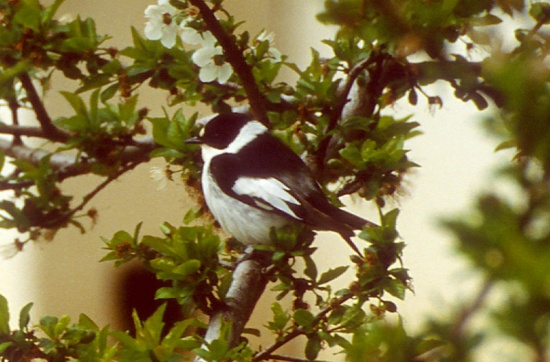(update link) |
(References updated) |
||
| (3 intermediate revisions by 2 users not shown) | |||
| Line 1: | Line 1: | ||
| − | [[Image:Collared_Flycatcher.jpg|thumb|550px|right|Photo by {{user|Theo+Mamais|Theo Mamais}}<br />Thessaloniki, [[Greece]], April 2003]] | + | [[Image:Collared_Flycatcher.jpg|thumb|550px|right|Photo © by {{user|Theo+Mamais|Theo Mamais}}<br />Thessaloniki, [[Greece]], April 2003]] |
;[[:Category:Ficedula|Ficedula]] albicollis | ;[[:Category:Ficedula|Ficedula]] albicollis | ||
==Identification== | ==Identification== | ||
| − | 12-13.5 cm<br /> | + | [[Image:Collared flycatcher.jpg|thumb|350px|right|Female<br />Photo © by {{user|ody|ody}}<br />Agios, Nikolaos, Naousa, Greece, May 2008]] |
| + | 12-13.5 cm (4¾-5¼ in)<br /> | ||
'''Male'''<br /> | '''Male'''<br /> | ||
*Black upperparts, tail and bill | *Black upperparts, tail and bill | ||
| Line 8: | Line 9: | ||
*Pale rump<br /> | *Pale rump<br /> | ||
''' Female''' and '''non breeding male''' - pale brown above, with white wing bars. White below. | ''' Female''' and '''non breeding male''' - pale brown above, with white wing bars. White below. | ||
| − | |||
====Similar Species==== | ====Similar Species==== | ||
The female [[European Pied Flycatcher]] has a very insignificant pale vertical mark leading from the white wing bar - in the female Collared this is noticeably broader and leads almost to the edge of the wing. | The female [[European Pied Flycatcher]] has a very insignificant pale vertical mark leading from the white wing bar - in the female Collared this is noticeably broader and leads almost to the edge of the wing. | ||
| − | Beware hybrid | + | Beware hybrid Pied × Collared which can look like [[Semicollared Flycatcher]]. |
==Distribution== | ==Distribution== | ||
Breeds eastern [[France]] to the Balkans and [[Ukraine]]. Winters in tropical and southern [[Africa]] (south of the equator). | Breeds eastern [[France]] to the Balkans and [[Ukraine]]. Winters in tropical and southern [[Africa]] (south of the equator). | ||
| Line 30: | Line 30: | ||
''[[Media:Ficedula albicollis (song).mp3|Listen in an external program]]'' | ''[[Media:Ficedula albicollis (song).mp3|Listen in an external program]]'' | ||
==References== | ==References== | ||
| − | #{{Ref- | + | #{{Ref-Clements6thAug19}}#Collins Bird Guide ISBN 0 00 219728 6 |
#Collins Field Guide 5th Edition | #Collins Field Guide 5th Edition | ||
{{ref}} | {{ref}} | ||
Revision as of 23:41, 8 September 2019
- Ficedula albicollis
Identification
12-13.5 cm (4¾-5¼ in)
Male
- Black upperparts, tail and bill
- White underparts, collar, large wing patch and forehead
- Pale rump
Female and non breeding male - pale brown above, with white wing bars. White below.
Similar Species
The female European Pied Flycatcher has a very insignificant pale vertical mark leading from the white wing bar - in the female Collared this is noticeably broader and leads almost to the edge of the wing.
Beware hybrid Pied × Collared which can look like Semicollared Flycatcher.
Distribution
Breeds eastern France to the Balkans and Ukraine. Winters in tropical and southern Africa (south of the equator).
Taxonomy
This is a monotypic species[1].
Habitat
Deciduous woodlands, parks and gardens.
Behaviour
Diet
The diet includes insects hawked aerially, caterpillars and berries.
Breeding
They nest in tree cavities; 5-7 eggs are laid.
Vocalisation
Song: a squeaky tsee-tsee-tsee-sui-see
<flashmp3>Ficedula albicollis (song).mp3</flashmp3>
Listen in an external program
References
- Clements, J. F., T. S. Schulenberg, M. J. Iliff, S. M. Billerman, T. A. Fredericks, B. L. Sullivan, and C. L. Wood. 2019. The eBird/Clements Checklist of Birds of the World: v2019. Downloaded from http://www.birds.cornell.edu/clementschecklist/download/
- Collins Bird Guide ISBN 0 00 219728 6
- Collins Field Guide 5th Edition
Recommended Citation
- BirdForum Opus contributors. (2024) Collared Flycatcher. In: BirdForum, the forum for wild birds and birding. Retrieved 25 April 2024 from https://www.birdforum.net/opus/Collared_Flycatcher





